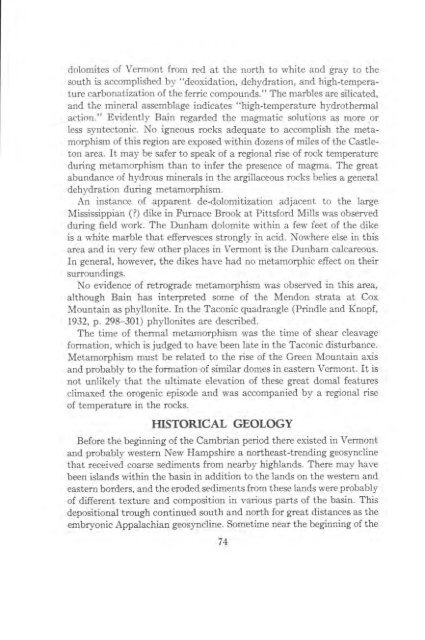STRATIGRAPHY AND STRUCTURE CASTLETON AREA VERMONT
STRATIGRAPHY AND STRUCTURE CASTLETON AREA VERMONT
STRATIGRAPHY AND STRUCTURE CASTLETON AREA VERMONT
Create successful ePaper yourself
Turn your PDF publications into a flip-book with our unique Google optimized e-Paper software.
dolomites of \ermont from red at the north to white and gray to the<br />
south is accomplished by "deoxidation, dehydration, and high-temperature<br />
carbonatization of the ferric compounds." The marbles are silicated,<br />
and the mineral assemblage indicates "high-temperature hydrothermal<br />
action." Evidently Bain regarded the magmatic solutions as more or<br />
less syntectonic. No igneous rocks adequate to accomplish the metamorphism<br />
of this region are exposed within dozens of miles of the Castleton<br />
area. It may be safer to speak of a regional rise of rock temperature<br />
during metamorphism than to infer the presence of magma. The great<br />
abundance of hydrous minerals in the argillaceous rocks belies a general<br />
dehydration during metamorphism.<br />
An instance of apparent de-dolomitization adjacent to the large<br />
Mississippian (?) dike in Furnace Brook at Pittsford Mills was observed<br />
during field work. The Dunham dolomite within a few feet of the dike<br />
is a white marble that effervesces strongly in acid. Nowhere else in this<br />
area and in very few other places in Vermont is the Dunham calcareous.<br />
In general, however, the dikes have had no metamorphic effect on their<br />
surroundings.<br />
No evidence of retrograde metamorphism was observed in this area,<br />
although Bain has interpreted some of the Mendon strata at Cox<br />
Mountain as phyllonite. In the Taconic quadrangle (Prindle and Knopf,<br />
1932, p. 298-301) phyllonites are described.<br />
The time of thermal metamorphism was the time of shear cleavage<br />
formation, which is judged to have been late in the Taconic disturbance.<br />
Metamorphism must be related to the rise of the Green Mountain axis<br />
and probably to the formation of similar domes in eastern Vermont. It is<br />
not unlikely that the ultimate elevation of these great domal features<br />
climaxed the orogenic episode and was accompanied by a regional rise<br />
of temperature in the rocks.<br />
HISTORICAL GEOLOGY<br />
Before the beginning of the Cambrian period there existed in Vermont<br />
and probably western New Hampshire a northeast-trending geosyncline<br />
that received coarse sediments from nearby highlands. There may have<br />
been islands within the basin in addition to the lands on the western and<br />
eastern borders, and the eroded sediments from these lands were probably<br />
of different texture and composition in various parts of the basin. This<br />
depositional trough continued south and north for great distances as the<br />
embryonic Appalachian geosyncline. Sometime near the beginning of the<br />
74













